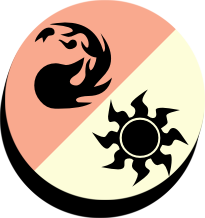The Fading Aurora
The Fading Aurora by Fletch
110 cards in Multiverse
86 commons, 23 uncommons, 1 mythic
14 white, 17 blue, 13 black, 14 red, 13 green,
21 multicolour, 2 hybrid, 8 artifact, 8 land
135 comments total
A lost Planeswalker tests the edges of Llorwyn and Shadowmoor
| The Fading Aurora: Cardlist | Visual spoiler | Export | Booster | Comments | Search | Recent activity |
| Mechanics | Skeleton |
Recently active cards: (all recent activity)
Aspect–Light (When this enters the battlefield, if you played it from your hand, choose Aspect–Light or Aspect–Dark. All permanents with that ability transform.)
2/1
Aspect–Dark (At the beginning of your end step, all permanents with Aspect–Light transform.)
When Tragic Hero dies, you may search your library for any number of cards named Confident Pilgrim, reveal them, put them into your hand, then shuffle your library.
When Tragic Hero dies, you may search your library for any number of cards named Confident Pilgrim, reveal them, put them into your hand, then shuffle your library.
1/1
This costs  less if you control a multicolored permanent.
less if you control a multicolored permanent.
Destroy target monocolored creature. Scry 1. (Look at the top card of your library. You may put that card on the bottom of your library.)
 less if you control a multicolored permanent.
less if you control a multicolored permanent.
Destroy target monocolored creature. Scry 1. (Look at the top card of your library. You may put that card on the bottom of your library.)
Counter target creature spell.
Draw a card.
If you control a multi-colored permanent, this costs less to cast.
less to cast.
Draw a card.
If you control a multi-colored permanent, this costs
 less to cast.
less to cast.Shepherd of Clans costs  less to cast for each creature you control with power of 1 or less.
less to cast for each creature you control with power of 1 or less.
 less to cast for each creature you control with power of 1 or less.
less to cast for each creature you control with power of 1 or less.4/4
Aspect–Light (When this enters the battlefield, if you played it from your hand, choose Aspect–Light or Aspect–Dark. All permanents with that ability transform.)

 , Sacrifice Venser’s Monitor: Draw a card and gain 2 life.
, Sacrifice Venser’s Monitor: Draw a card and gain 2 life.

 , Sacrifice Venser’s Monitor: Draw a card and gain 2 life.
, Sacrifice Venser’s Monitor: Draw a card and gain 2 life.1/1
Aspect–Dark (At the beginning of your end step, all permanents with Aspect–Light transform.)
 ,
,  , Sacrifice Venser’s Tracker: Venser’s Tracker deals 1 damage to target player. That player discards a card. Use this ability only when you could play a sorcery.
, Sacrifice Venser’s Tracker: Venser’s Tracker deals 1 damage to target player. That player discards a card. Use this ability only when you could play a sorcery.
 ,
,  , Sacrifice Venser’s Tracker: Venser’s Tracker deals 1 damage to target player. That player discards a card. Use this ability only when you could play a sorcery.
, Sacrifice Venser’s Tracker: Venser’s Tracker deals 1 damage to target player. That player discards a card. Use this ability only when you could play a sorcery.1/1
Recent comments: (all recent activity)
See other cardsets


 Creature – Kithkin Scout
Creature – Kithkin Scout





Love the flavor.
This would now use daybound/nightbound tech, I suppose.
"multicolored" is not a hyphenated term.
It probably would be advisable to line up different conditional cost reduction abilities e. g. between this and A Shadow of Itself. One caring about any multicolored permanent and the other just about creatures is a barrier.
I take some slight offense to the notion that the WHOLE set is a parasitic mess, but I do think the suggestion that the Dark aspect generally tie itself to multi-color cards is interesting. It’d definitely make the Dark side feel more attuned to Shadowmoor, while the Light side favored Lorwyn.
The more you mention the two Aspect keywords, the more obvious it becomes that this set isn't an organic design that fits itself nicely into the greater whole and just a parasitic mess.
And this isn't even a flavorful card. Neither is it playing on the duality theme by discerning which of the two modes is current for your side - it does the same no matter whether it's "Light" or "Dark".
Even if this cared about any DFC, then the fact that it cares about DFC itself is not making it all that much more modular - and you have multiple of these card designs.
I feel like you need a distinct theme for the "Light" and "Dark" side that allows you to distinguish them without mentioning them (e. g. all "Light" sides are monocolored/all "Dark" sides are multicolored) or have another distinct gamestate (e. g. you can only switch to the "Dark" side once you have seven cards in your graveyard - threshold/delirium/ascend style).
This is quite a color intensive and weird mana cost for common.
The mechanic seems like it would be best put on a card with high generic mana cost.
Even at its cheapest this is a multicolored 4/4 for three - wouldn't a simple erstriction to counting any creature you control be sufficient?
Doesn’t bother me at all. Dinosaur tribal cards are as parasitic as this card is, and it’s not a big deal. Energy is parasitic by these standards. also not a big deal. A card that specifically references a plot point of a set and plays in complement to a large mechanical theme of that set isn’t always purely parasitic.
Do designers avoid it if it’s unwarranted? Absolutely. In this case, the environment makes it a reasonable design.
> I want the card to see stuff existing near the edges of the Aurora, not Werewolves on Innistrad.
I'm not sure what you're saying here so I don't get the issue - flavor related stuff I guess?
Designers generally prefer less parasitism. With "could transform" I could see this being reprinted with new context, which I think is pretty nice as well. Beyond that, it's more flexible yet, it doesn't affect the card's function in the environment at all (... so flavor remains untainted, right?), and is likely easier to grok because of its higher elegance. The current rules text gives me eerie feeling of yu-gi-oh, which probably isn't good.
All fine and good, but “transformable” isn’t the subset I want the card to find. I want the card to see stuff existing near the edges of the Aurora, not Werewolves on Innistrad.
Obviously mentioning an ability word couldn't work since it has no meaning on its own and you can take it out without changing the card at all (Sporemound kinda has landfall). This doesn't compare to transform at all since it's an action.
Literally the first rule I can find regarding transform is:
> 701.27a To transform a permanent, turn it over so that its other face is up. Only permanents represented by double-faced cards can transform. (See rule 711, "Double-Faced Cards.")
https://mtg.gamepedia.com/Transform
Clear as day to me - I didn't need to look up that ruling to know it.
"Could do something" is seen in cards such as Exotic Orchard btw.
I’m reasonably certain that a card asking to check for a subset of permanents with a certain quality, ability, or function needs a “solid” tag of some kind — like a type, subtype, color, or keyword ability — in order to find said permanents. i.e., you can say that “attacking creatures with first strike get trample until end of turn”, but you can’t say “sacrifice all permanents with morbid” (since morbid is an ability word that describes a thematically linked action, but has no meaning on its own).
In this case “could transform” doesn’t cleanly define a subset of permanents by the rules of the game, but “has /specific ability/” does.